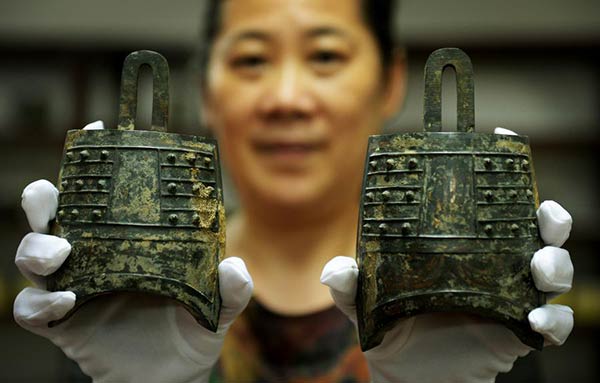 |
|
Photo taken on Aug 6, 2015 shows an archaeologist displaying cultural relics unearthed from the excavation site of royal tombs of Marquis of Haihun State during the Western Han Dynasty (206 BC-25 AD) in Nanchang, capital of East China's Jiangxi province. [Photo/Xinhua] |
Chinese archeologists announced Wednesday the discovery of the most complete Western Han Dynasty (206 BC- 25 AD) cemetery.
The Haihunhou cemetery is located a kilometer from the nearest village in Nanchang, capital of East China's Jiangxi province. It covers some 40,000 square meters with eight tombs and a chariot burial site with walls that stretch for almost 900 meters.
Archeologists suspect that the main tomb is that of Liu He, grandson of Emperor Wu, the greatest ruler of Han Dynasty, one of the most prosperous periods in China's history. Liu was given the title "Haihunhou" (Marquis of Haihun) after he was deposed as emperor after only 27 days, dethroned by the royal clan because of his lack of talent and morals. Haihun is the ancient name of a very small kingdom in the north of Jiangxi.
Xu Changqing, director of Jiangxi provincial cultural relics research institute, said on Wednesday that the cemetery is the most complete and best preserved Han Dynasty tomb cluster ever discovered. Archeologists can clearly see the foundations of the tombs thought to be of Haihunhou and his wife, as well as affiliated memorial temples. There are roads and drainage systems in the cemetery.
The team have found more than 10 tonnes of Wuzhu bronze coins together with more than 10,000 other gold, bronze and iron items, unearthed along with jade articles, wood tablets and bamboo slips, said Xin Lixiang of the China National Museum, who heads the team at the site. Xin has studied some 4,000 Han Dynasty tombs.
Xin said the next stage of the archeological work will be to look for items locked in the coffin of the central mausoleum.
"There may be a royal seal and jade clothes that will suggest the status and identity of the tombs occupant," he said.
|
|
|
|
|
|
|
|
